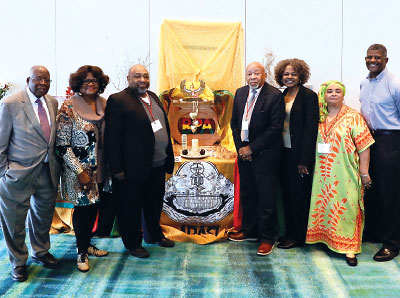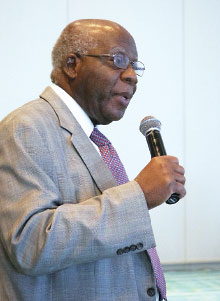On Its 50th Anniversary, BPA Looks Back on History and Ahead to Future
Abstract
At the annual spring meeting of the Black Psychiatrists of America, its elders recalled the organization’s origins and reflected upon the work yet to be done in the fight against racism and disparity in mental health care.
When Chester M. Pierce, M.D., and 15 of his fellow black psychiatrists walked into the APA Board of Trustees meeting in Florida in 1969, they had one goal in mind: Change. They presented 10 demands to the Board, demands that if met would provide rightful equity for black psychiatrists in the profession and among the profession’s leadership, as well as equity for black patients.

Officers and elders of the Black Psychiatrists of America gather before a memorial honoring prominent black psychiatrists and commemorating black history. From left: Samuel O. Okpaku, M.D., Ph.D., president; Shirley Marks, M.D., M.P.H., past president; William B. Lawson, M.D., Ph.D., treasurer; Billy E. Jones, M.D., M.S., member of the Council of Elders; Cassandra Newkirk, M.D., M.B.A., member of the Council of Elders; Patricia A. Newton, M.D., M.P.H., M.A., CEO and medical director, past president, and member of the Council of Elders; and Michael Ingram, M.D., immediate past president.
“They said that our patients were being discriminated against and marginalized, and we have no say in the matter, and that has to change,” said Orlando B. Lightfoot, M.D., in the session titled “BPA at 50: Origin, History, and Future” at the Black Psychiatrists of America 50th Anniversary Psychiatry Conference and Celebration in April at National Harbor, Md. The session was chaired by Cassandra Newkirk, M.D., M.B.A.
The frustration that led to the 10 demands also led to the formation of BPA, whose mission is to “address issues affecting the mental health of African people worldwide, with special emphasis on persons of African descent in the Americas, and to provide a forum for continuing education for those who provide psychiatric care to these underserved population groups.” Pierce was the BPA’s first president.
At the time of BPA’s creation, Lightfoot, now emeritus professor of psychiatry at Boston University School of Medicine, was part of a group of “Young Lions”—black psychiatrists fresh out of training who shared with the APA Board their experiences within predominately white training institutions. From Lightfoot’s 50-year vantage point, it’s apparent that the work begun with the inception of BPA is not only still relevant and necessary, it is permanent.
“Racism and white supremacy are as pernicious today as they were in 1969. Managing, dealing with, and educating ourselves and others about racism is a never-ending process,” Lightfoot said. “Continue to do whatever you can wherever you are. You’re not going to solve the problem, but you are going to help with the understanding of it. Accepting the magnitude of racism helps to marshal resources to more readily manage its impact.”
In a presentation following Lightfoot’s, Billy E. Jones, M.D., a clinical professor of psychiatry at New York University and a fellow Young Lion, noted how it wasn’t until some years later in the life of the organization that BPA acquired dedicated office space, and he encouraged attendees to consider BPA’s continued growth.
“For many years BPA was run out of the president’s office or home with no organizational staff,” Jones said. “What do we want and need the organization to focus on in today’s world? It needs to change and grow with the issues and the needs of the times. The challenge for us today is how do we do that?”
Denese Shervington, M.D., M.P.H., chair of the Department of Psychiatry at Charles R. Drew University of Medicine and Science, spoke of a need for strategic planning.

BPA must stand as a watch dog in matters of fairness and equity. —Samuel O. Okpaku, M.D., Ph.D.
“What are the ideas, solutions, and prototypes we can generate or propose for a sustainable future that honors the past and keeps us relevant in the present?” she asked attendees.
In an interview with Psychiatric News after the conference, BPA President Samuel O. Okpaku, M.D., Ph.D., emphasized the importance of BPA’s vigilance regarding mental health care not only in the black community but in all communities.
“BPA is going to be the watchdog in matters of fairness and equity. BPA has to remain active in social policy and advocacy. We need to broaden the diasporic movement and include all minority groups,” Okpaku said.
“Black psychiatry is not only for people who have black skin,” he added. “We are interested in providing accessibility, equity, fairness, representation, and diversity. We know that where there is more diversity, there is more creativity, and there are fewer blind spots.”
APA President Altha Stewart, M.D., noted several ways that APA and BPA can work together to address the obstacles that black psychiatrists, psychiatry trainees, and patients face in mental health care.
“BPA represents a unique opportunity for APA to have, as an allied group, the experts and people who have done most of the training, research, and clinical care and understand what is best for black patients. [BPA members] have done the research and written the training on cultural competence as it relates to the black community in the health arena,” Stewart told Psychiatric News after the conference.
“APA can use its larger footprint to expand on this,” said Stewart, who is APA’s first black president and co-chair of BPA’s Council of Elders and chair of its 50th Anniversary Committee. “APA can call on BPA as a partner when it needs that level of expertise and diversity. APA can move the needle in expanding our role in clinical research, and BPA can be a strong partner and bring experts in that APA as a group simply does not possess.”
Stewart expressed gratitude for the psychiatrists who laid out their demands before APA’s Board 50 years ago, stating that their work blazed the trail for APA’s Minority and Underrepresented Caucuses and ultimately her APA presidency.
“Thanks to the black psychiatrists who were members of APA at the time and were part of this movement, it led to the establishment of racial, ethnic, sexual, and gender-based minority groups that were brought into APA in a meaningful way,” Stewart said. ■



